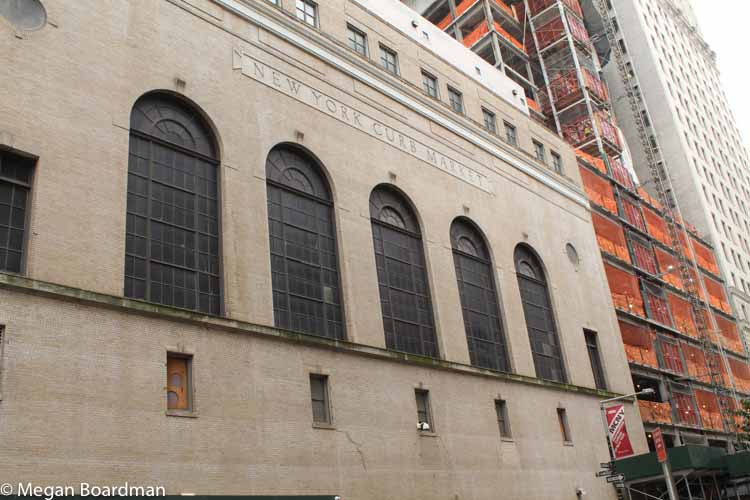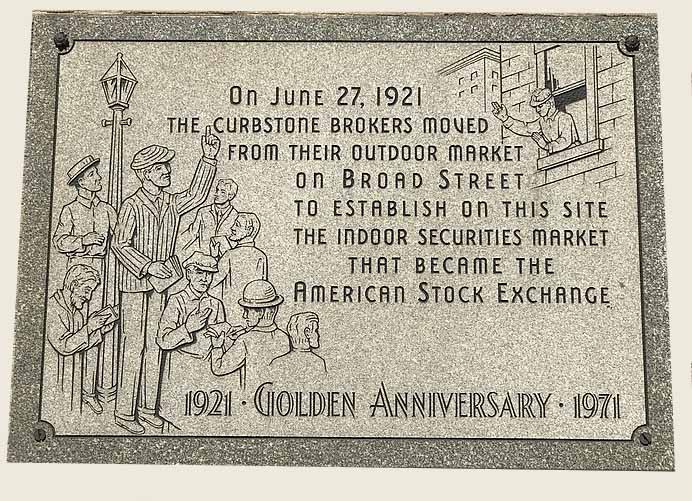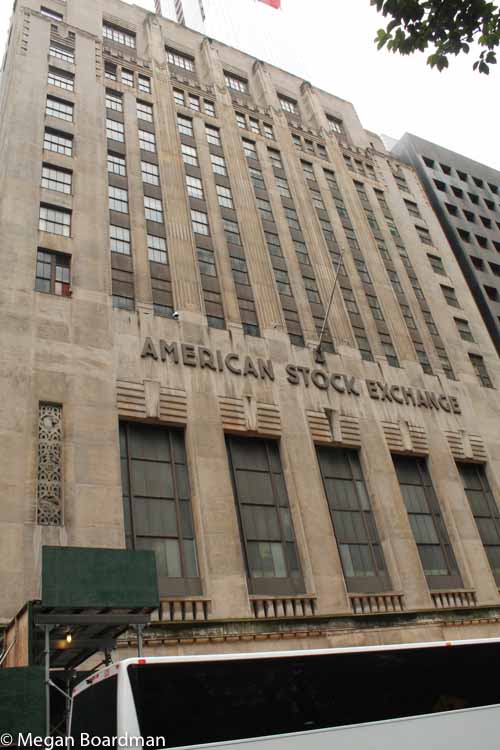The building's Wikipedia
page explains that,
"... New
York's stock trading activity
historically took place in outdoor
spaces until 1792, when a predecessor to
the NYSE was founded, and some trading
moved into their building. Trading
continued to take place "on the curb"
outside the NYSE. The outside traders
benefited from the NYSE's refusal to
allow trade in some types of securities,
and became a leading marketplace for
non-listed securities. This market had
no fixed location, moving around as
traffic and other conditions
dictated. Starting in the 1880s,
Emanuel S. Mendels and Carl H.
Pforzheimer attempted to standardize the
loosely organized curb market of
curbstone brokers on Broad Street.
The New York Curb Market Agency
was established in 1908 to codify
trading practices. Three years later,
the curbstone brokers had come to be
known as the New York Curb Market, with
a formal constitution and brokerage and
listing standards. The Curb Market had
offices in the Broad Exchange Building
at Broad Street and Exchange Place,
though trading remained outdoors."

"The Curb Market
purchased a 26,000-square-foot ....
L-shaped plot between Greenwich Street
and Trinity Place in December 1919 for
$1.6 million ..... The site had been the
former location of a building occupied
by the American Bank Note Company.
.... Blueprints for the
Curb Market structure were filed with
the city government in November 1920.
... The building opened
on June 27, 1921, at which point the New
York Curb Exchange was the second
largest in the U.S., behind the
NYSE. After moving indoors, the
Curb Market grew to include a wide
selection of issues, including
"high-class industrial, public
utilities, oils and domestic and foreign
bonds" and within ten years, the Curb
Market had 2,300 stocks on its list."

"By 1929, the Curb
Market had outgrown the operations of
the original building. That year, the
Curb's building committee proposed
adding eight office floors above the
board room, as well as expanding the
board room, thus extending the Curb
Market building into the remaining
undeveloped portion of its lot .... The
Curb Exchange rehired Starrett & Van
Vleck to build the annex. Plans were
filed with the city government in
January 1930, and construction of the
annex started the next month ... The
Curb Exchange was renamed the American
Stock Exchange (AMEX) in 1953, and the
exterior signage on Trinity Place was
changed accordingly."
"NYSE acquired AMEX in January 2008, and
AMEX sold off their building. On
December 1 of that year, the American
Stock Exchange Building was closed, and
both the Amex Equities and Amex Options
trading floors were moved to the NYSE
Trading floor at 11 Wall Street. In
2011, the American Stock Exchange
Building and the neighboring Western
Electric building at 22 Thames Street
were purchased by the partnership of
Michael Steinhardt and Allan Fried at a
cost of $65 million, a quarter of which
was spent on the AMEX building. The
partnership announced plans to renovate
the Greenwich Street building into a
retail structure with a hotel, and
destroy 22 Thames Street, raising
concerns from preservationists and
neighborhood residents. The New York
City Landmarks Preservation Commission
subsequently designated the building as
a city landmark in June 2012."



